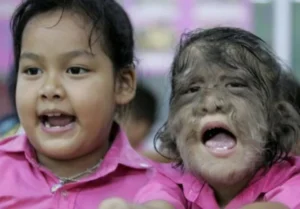Supatra Sasufan, an extraordinary young woman from Thailand, captured global attention at a very early age when she was inducted into the Guinness Book of Records. However, unlike many others who earn such recognition for exceptional talents or remarkable physical achievements, Supatra’s claim to fame was something far more unique: her condition of being covered with an unusual amount of hair. This rare medical condition earned her the title of the “hairiest girl in the world.”

Supatra’s journey has been nothing short of challenging. From her earliest days, she and her family struggled to navigate the complexities of living with a condition that remains without a cure. The medical term for her condition is Ambras Syndrome, also known as werewolf syndrome, a rare genetic disorder characterized by excessive hair growth on the face and body. This condition, although fascinating in its uniqueness, posed significant challenges for Supatra and her loved ones.
Over the years, Supatra and her parents explored numerous treatment options in hopes of alleviating the symptoms of this condition. One of the most promising avenues they pursued was laser hair removal therapy, a treatment often touted as a solution for reducing unwanted hair. Unfortunately, this method proved ineffective for Supatra. Instead of curbing the hair growth, the treatment seemed to have an adverse effect, causing the hair to grow back even thicker and faster than before. Despite these setbacks, her family remained steadfast in their support, helping her embrace her individuality and navigate the complexities of her condition.
Growing up, Supatra faced the additional challenge of societal perceptions. Attending school was particularly difficult as she became a target for ridicule from her peers. The taunts and teasing were relentless, with many children failing to understand the medical reality behind her condition. However, Supatra’s resilience shone through these adversities. Despite the negativity, she managed to build meaningful friendships with peers who looked beyond her appearance and valued her for who she was. She often expressed gratitude for her friends who treated her with kindness and respect, serving as a vital source of strength and comfort.
As the years passed, Supatra learned to adapt and find ways to cope with her condition. Now 17 years old, she has developed a sense of self-assurance and resilience that allows her to face life with courage and positivity. This maturity is evident in the way she handles public curiosity and online discussions about her appearance. Recently, she made headlines once again when photos of her and her spouse surfaced online. Although Supatra prefers to keep the identity of her husband private, these photos quickly went viral, drawing a mix of reactions from the public.
The online community’s response to her story has been largely supportive, with many people offering words of encouragement and admiration. In the comments on her photos, users applauded her strength and courage, recognizing her journey as one of resilience and determination. For Supatra, maintaining her appearance requires regular grooming, including shaving her face to manage the excessive hair growth. While this routine might seem burdensome to others, she approaches it as a necessary part of her life, demonstrating her ability to adapt and thrive despite the challenges she faces.
Supatra’s story serves as a powerful testament to the human spirit’s ability to overcome adversity. Her journey reminds us of the importance of acceptance, compassion, and understanding. While her condition might set her apart physically, her determination, kindness, and inner strength define her far more profoundly.

Living with Ambras Syndrome is no easy feat, not just because of the physical implications but also due to the societal pressures and stigma associated with looking different. Supatra’s experiences highlight the importance of raising awareness about rare medical conditions. By sharing her story, she has become an advocate for greater understanding and empathy, helping to challenge stereotypes and reduce the stigma often associated with visible differences.
Her story also sheds light on the medical community’s ongoing need to research and develop treatments for rare genetic disorders. While Ambras Syndrome is an extremely rare condition, affecting only a handful of individuals worldwide, the challenges faced by those living with it are universal in nature—the desire for acceptance, the struggle for self-esteem, and the quest for normalcy. Supatra’s journey underscores the need for medical advancements that not only address physical symptoms but also provide emotional and psychological support for individuals and their families.

Beyond the medical and social aspects, Supatra’s story offers valuable lessons in resilience and self-acceptance. Her ability to embrace her uniqueness and maintain a positive outlook on life is nothing short of inspiring. She has shown the world that true beauty lies not in conformity but in individuality. By choosing to share her journey with the world, she has inspired countless others to embrace their own differences and find strength in their personal struggles.
Supatra’s resilience is also a testament to the power of family support. Her parents’ unwavering love and dedication played a crucial role in helping her navigate the challenges of living with Ambras Syndrome. They sought medical advice, explored treatment options, and provided her with the emotional support needed to face a world that often judged her unfairly. Their efforts underscore the importance of a strong support system in overcoming life’s challenges.

In recent years, Supatra’s story has reached audiences far beyond her local community, thanks to the power of social media and online platforms. Her photos and story have sparked conversations about beauty standards, acceptance, and the need for greater inclusivity in our society. Many people have praised her for her courage and strength, viewing her as a role model for embracing one’s individuality and facing life’s challenges head-on.
Supatra’s journey is also a reminder of the impact of kindness and empathy. The friends who stood by her during her school years and the strangers who offer words of encouragement online play a vital role in shaping a more compassionate and inclusive world. Their support serves as a powerful reminder that small acts of kindness can have a profound impact on someone’s life.
Looking ahead, Supatra’s future holds the promise of continued growth and self-discovery. As she transitions into adulthood, she will undoubtedly face new challenges, but her resilience and determination will continue to guide her. Her story serves as an enduring example of the power of perseverance and the importance of embracing one’s unique identity.

To those who might be facing similar challenges or feel defined by their differences, Supatra’s story offers a beacon of hope and inspiration. She has shown that while our external appearances might set us apart, it is our inner strength, character, and ability to overcome adversity that truly define us.
In conclusion, Supatra Sasufan’s life is a remarkable journey of resilience, courage, and self-acceptance. Her story reminds us of the importance of compassion, understanding, and the strength that lies within us all. As we send her our thoughts of patience and strength, we can only hope that her journey continues to inspire others to embrace their uniqueness and find beauty in the diversity of the human experience.





